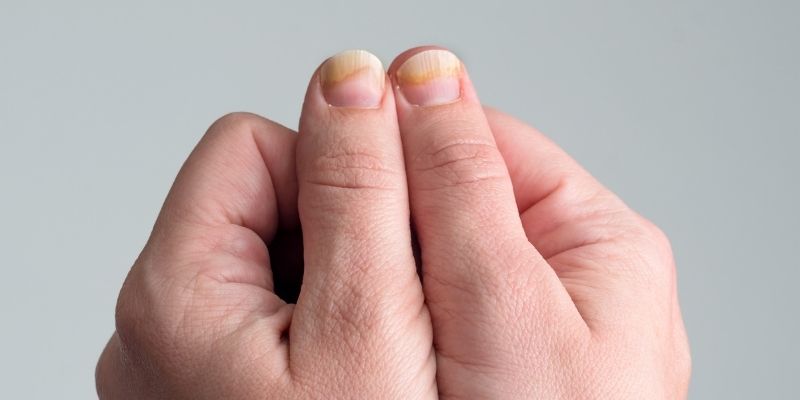Advertisement
Nails may appear negligible, yet they may reveal our health. Nail changes may suggest health difficulties, although healthy nails usually indicate good health. Understanding what your nails are saying may help you spot health issues early and enhance your health. Your nails' color, shape, and texture might indicate your inside wellness. Discoloration, brittleness, or aberrant development patterns might suggest dietary deficits, liver illness, or heart disease. This article will discuss nine things your nails may indicate about your health, how to maintain healthy nails, and when to seek medical treatment for abnormal nail changes.

White nails with darker rims may indicate "Terry's nails." Terry's nails typically indicate cirrhosis, heart failure, or diabetes. The lack of pink hue may suggest liver or nail bed blood flow issues. If you observe this change, see a doctor for testing.
Nail yellowing has several reasons. Fungal infections usually cause it; however, they may also signal as lung, thyroid, or diabetes. Smokers' nails may become yellow from nicotine and tar. See a doctor if the yellowing continues and is accompanied by other symptoms.
Your nails becoming blue may indicate low oxygen levels. Cyanosis is caused by respiratory or circulatory issues such as COPD, asthma, or heart disease. Bluish nails, particularly if accompanied by shortness of breath or chest discomfort, need medical attention.
Age-related vertical nail ridges are common. They may suggest a vitamin B12 or iron shortage if they are more severe. Vertical ridges may indicate dehydration or thyroid issues. See a doctor if this change is abrupt or accompanied by other strange symptoms.
Beau's lines are horizontal nail ridges. A high temperature, severe infection, or surgery might cause these lines. They may also arise under stress or starvation. Beau's lines may indicate diabetes, peripheral vascular disease, or zinc insufficiency. If these lines continue or are followed by other health issues, visit a doctor.
Brittle, cracked, or broken nails may indicate dehydration, over-washing, or chemical exposure. Brittle nails with weariness, hair loss, or dry skin may suggest a thyroid disease, particularly hypothyroidism. Iron deficiency anemia and malnutrition may cause brittle nails. Healthcare professionals can diagnose these symptoms.
Iron deficiency anemia may cause spoon-shaped nails that dip in the center and rise at the edges. The body struggles to make healthy red blood cells when iron levels are low. Spoon nails may suggest thyroid, heart, or diabetes. If you see this nail change, check your iron levels and visit a doctor.
Round nails and bulging fingertips are called clubbing. This may signal a significant health concern like COPD, lung cancer, heart disease, or Crohn's disease. Clubbing affects the structure of fingers and nails and indicates persistent low blood oxygen levels. Clubbed nails need medical attention.
Psoriasis, an inflammatory disease that inflames the skin, may cause nail pitting. Alopecia areata, when the immune system assaults hair follicles, may cause pitting. Pitting nails may sometimes be linked to rheumatoid arthritis or parathyroid illness. If you have pitting nails and other symptoms, see a doctor.

Healthy nails need more than cosmetic care. Good diet, cleanliness, and chemical protection keep nails solid and vivid. Ten nail care tips:
Some nail abnormalities are innocuous and may be fixed with better care or diet, while others may indicate a severe illness. Sudden or severe nail color or texture changes need medical care. Consult a doctor if your nails change drastically in form, color, or texture, particularly without evident damage. If your nail pain doesn't improve with at-home treatment, you may have an infection, injury, or other primary health concern that requires medical attention. Swelling or redness around the nails may indicate infection, which may progress swiftly if untreated.
Nutritional deficiencies, thyroid difficulties, and autoimmune illnesses may cause nail growth or loss changes. If your nails stop growing or fall off abruptly, visit a doctor. Nail changes with weariness, fever, weight, or joint discomfort need medical attention. These symptoms may indicate a systemic illness that requires medical attention.
Your nails may reveal your health. Discoloration, texture changes, or ridges in your nails might indicate vitamin deficits, heart disease, lung illness, and even cancer. You may proactively keep your nails and health healthy by following nail care instructions and knowing when to seek expert treatment. Nails are more than cosmeticthey indicate your body's health. Please pay attention to them to detect health issues early and improve long-term health.
Advertisement

By Darnell Malan/Nov 19, 2024

By Mason Garvey/Dec 07, 2024

By Celia Kreitner/Sep 27, 2024

By Sean William/Dec 07, 2024

By Verna Wesley/Oct 12, 2024

By Elva Flynn/Nov 16, 2024

By Vicky Louisa/Nov 10, 2024

By Darnell Malan/Nov 05, 2024

By Madison Evans/Oct 10, 2024

By Christin Shatzman/Sep 28, 2024

By Elva Flynn/Nov 13, 2024

By Elva Flynn/Nov 15, 2024